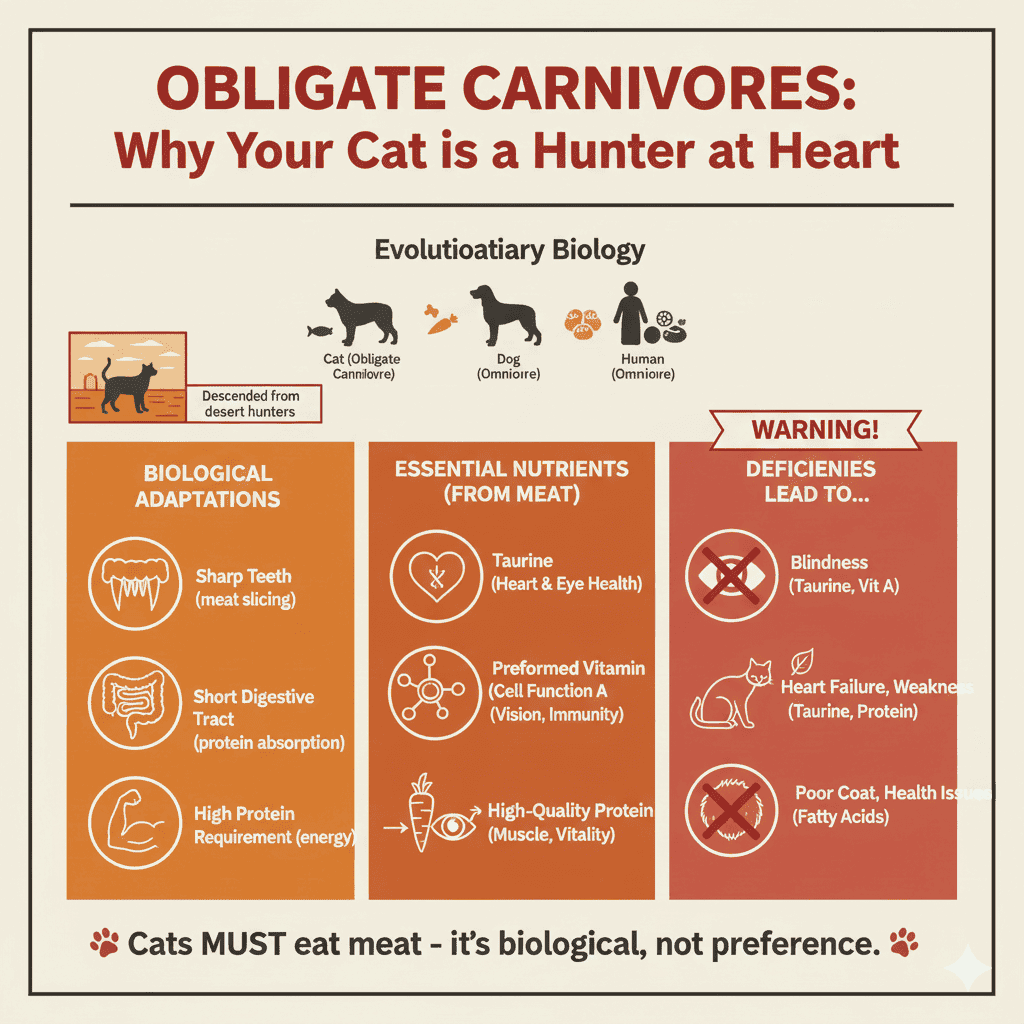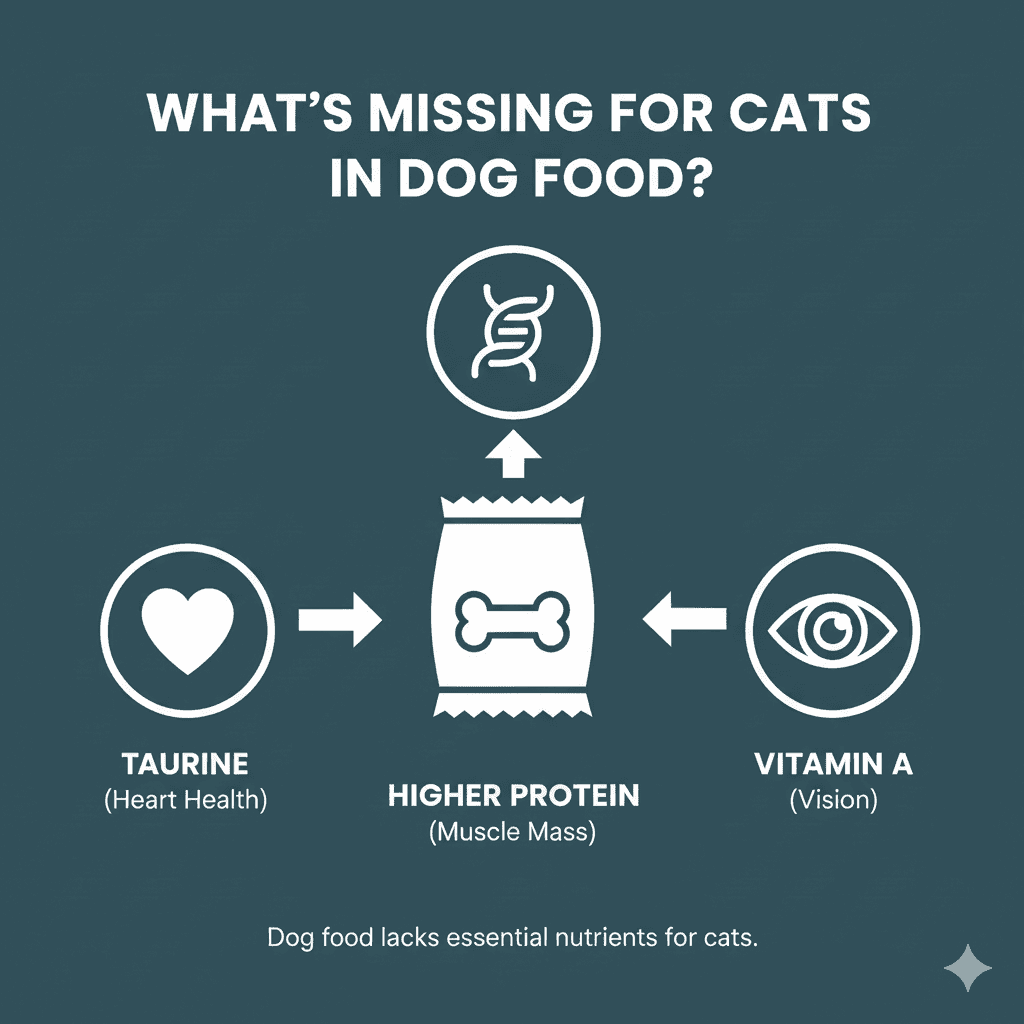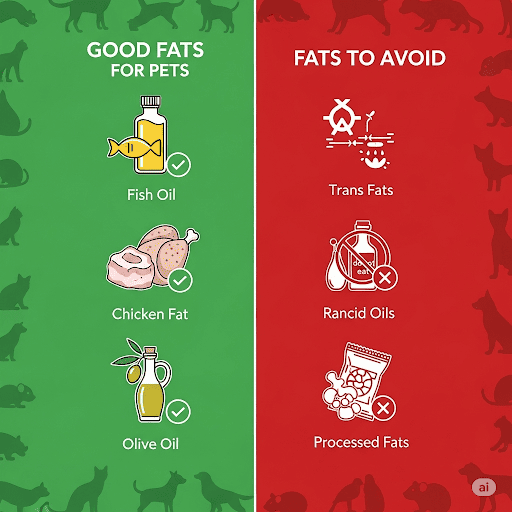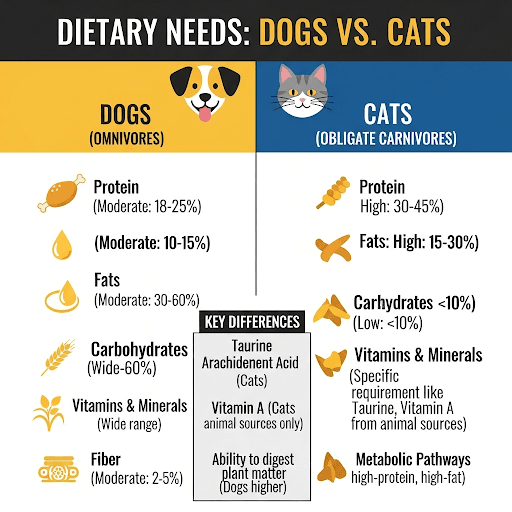Your cat may curl up on your lap like a fluffy pillow, purr contentedly, and seem like the most domesticated creature on Earth. But beneath that gentle exterior lies the heart of a predator—a biological design that has remained virtually unchanged for millions of years.
Cats are obligate carnivores, meaning they have an absolute biological requirement for animal-based nutrition. Unlike dogs (who are omnivores) or humans (who are also omnivores), cats cannot thrive on a plant-based diet. Their bodies are specifically designed to consume, digest, and utilize animal tissue.
Understanding what "obligate carnivore" really means is crucial for every cat owner. It's not a preference or a recommendation—it's a biological necessity that shapes every aspect of your cat's nutritional needs.
What Does "Obligate Carnivore" Really Mean?
The term "obligate carnivore" comes from the Latin word "obligatus," meaning "bound" or "compelled." In biological terms, it means:
Obligate = Required, necessary, cannot be avoided Carnivore = Meat-eater
So an obligate carnivore is an animal that must eat meat to survive. They cannot obtain all their required nutrients from plant sources, no matter how carefully those plants are prepared or supplemented.
Obligate vs. Facultative Carnivores
- Obligate carnivores (like cats): Must eat meat; cannot survive without it
- Facultative carnivores (like dogs): Can eat meat but can also survive on plant-based diets with proper supplementation
This distinction is crucial. While a dog can theoretically thrive on a well-formulated vegetarian diet, a cat cannot—their biology simply doesn't allow it.
The Evolutionary Story: Why Cats Are Built This Way
Cats evolved as solitary hunters, specializing in catching and consuming small prey animals. This evolutionary path shaped their entire biology:
1. The Hunting Heritage
- Ancestors: All domestic cats descended from the African wildcat (Felis silvestris lybica)
- Hunting style: Ambush predators that catch small mammals, birds, and reptiles
- Diet: Almost exclusively animal tissue (muscle, organs, bones)
- Timeline: This diet has been consistent for millions of years
2. No Evolutionary Pressure to Change
Unlike dogs, who evolved alongside humans and adapted to eat our scraps (including grains and vegetables), cats maintained their wild diet. They didn't need to adapt to plant-based foods because:
- They remained effective hunters
- They didn't rely on human food waste
- Their biology worked perfectly for their lifestyle
3. The Biological Lock-In
This long evolutionary history "locked in" specific biological adaptations that cannot be easily changed. Your house cat has the same nutritional requirements as a wild lion—just in smaller portions.

The Biological Adaptations of Obligate Carnivores
Cats have numerous biological adaptations that reflect their carnivorous nature:
1. Digestive System
Short digestive tract:
- Cats have a relatively short gastrointestinal tract compared to omnivores
- Designed for quickly digesting high-protein, low-fiber animal tissue
- Less efficient at breaking down plant matter
High stomach acidity:
- pH of 1-2 (very acidic)
- Necessary for digesting raw meat and killing bacteria
- More acidic than dogs or humans
Limited carbohydrate digestion:
- Cats have limited ability to digest complex carbohydrates
- They lack certain enzymes needed for plant digestion
- Their digestive system is optimized for protein and fat
2. Metabolic Adaptations
Protein metabolism:
- Cats have a constant, high demand for protein
- They use protein for energy (not just for building tissues)
- Their metabolism is always in a "protein-burning" mode
Limited ability to regulate protein breakdown:
- Unlike omnivores, cats cannot easily reduce protein breakdown when intake is low
- They continue breaking down their own muscle tissue if dietary protein is insufficient
- This is why cats need high-protein diets
Fat metabolism:
- Efficient at using fat for energy
- Can handle high-fat diets (like their prey)
- Fat provides essential fatty acids they cannot synthesize
3. Dental Structure
Sharp, pointed teeth:
- Designed for tearing meat, not grinding plants
- Canines for gripping and killing prey
- Molars for shearing meat, not grinding grains
- No flat molars for grinding plant matter
4. Behavioral Adaptations
Hunting behavior:
- Even well-fed house cats retain hunting instincts
- They're crepuscular (most active at dawn and dusk—prime hunting times)
- Play behavior mimics hunting
Eating patterns:
- Prefer multiple small meals (like catching multiple small prey)
- May eat 10-20 small meals per day if food is available
- Natural grazers when food is abundant
Essential Nutrients Cats Cannot Get from Plants
Several nutrients are either absent from plants or in forms cats cannot utilize:
1. Taurine
Why it's critical:
- Essential amino acid (cats cannot synthesize it)
- Required for heart function, vision, reproduction, and immune function
- Only found in significant amounts in animal tissue
What happens without it:
- Dilated cardiomyopathy (heart disease)
- Retinal degeneration (blindness)
- Reproductive failure
- Immune system problems
- Death
Plant sources: None adequate. Synthetic taurine must be added to plant-based cat foods.
2. Arachidonic Acid
Why it's critical:
- Essential fatty acid
- Cats cannot convert linoleic acid to arachidonic acid (unlike dogs)
- Required for skin health, kidney function, and reproduction
What happens without it:
- Poor skin and coat condition
- Kidney problems
- Reproductive issues
Plant sources: None. Only found in animal tissue.
3. Preformed Vitamin A
Why it's critical:
- Cats cannot convert beta-carotene (from plants) to vitamin A
- They must get preformed vitamin A (retinol) directly
- Required for vision, immune function, and reproduction
What happens without it:
- Night blindness
- Poor immune function
- Reproductive problems
Plant sources: Only beta-carotene (which cats cannot convert). Must come from animal sources.
4. Niacin (Vitamin B3)
Why it's critical:
- Cats have a high requirement for niacin
- They cannot efficiently convert tryptophan to niacin (unlike dogs)
- Must get niacin directly from diet
What happens without it:
- Weight loss
- Inflammation of the mouth and tongue
- Diarrhea
- Death in severe cases
Plant sources: Limited. Best sources are animal tissues.
5. High-Quality Protein
Why it's critical:
- Cats need more protein than dogs (minimum 26% for adults vs. 18% for dogs)
- They need specific amino acids in specific ratios
- Animal proteins provide complete amino acid profiles
What happens without adequate protein:
- Muscle wasting
- Poor growth (in kittens)
- Weakness
- Organ dysfunction
Plant sources: Incomplete amino acid profiles. Multiple plant sources must be combined, and even then, bioavailability is lower.
The Protein Requirement: Why Cats Need So Much
Cats have the highest protein requirement of any common domestic pet:
Minimum Requirements
- Adult cats: Minimum 26% protein (dry matter basis)
- Growing kittens: Minimum 30% protein
- Dogs (for comparison): Minimum 18% protein
Why So High?
- Constant protein breakdown: Cats are always breaking down protein, even at rest
- Protein for energy: They use protein as an energy source, not just for building tissues
- Limited ability to conserve protein: Unlike omnivores, they can't easily reduce protein breakdown
- High-quality requirement: Not just quantity—they need high-quality, bioavailable protein
What "High-Quality" Means
High-quality protein for cats means:
- Animal-based: From meat, fish, eggs, or dairy
- Complete amino acid profile: Contains all essential amino acids
- Highly digestible: Easy for cats to break down and absorb
- Bioavailable: The amino acids are in forms cats can use
Plant proteins are lower quality for cats because:
- Incomplete amino acid profiles
- Lower digestibility
- Lower bioavailability
- Missing or insufficient essential nutrients
What Happens When Cats Don't Get Animal-Based Nutrition?
Short-Term Effects
- Lethargy: Lack of energy
- Poor coat condition: Dull, dry fur
- Weight loss: Despite adequate calories
- Muscle wasting: Loss of muscle mass
Long-Term Effects
- Heart disease: From taurine deficiency
- Blindness: From taurine deficiency
- Kidney problems: From various nutrient deficiencies
- Immune system problems: Increased susceptibility to disease
- Reproductive failure: Cannot reproduce successfully
- Premature death: From multiple organ failures
The "Vegetarian Cat" Myth
Some people attempt to feed cats vegetarian or vegan diets. This is:
- Biologically inappropriate: Goes against millions of years of evolution
- Nutritionally inadequate: Even with supplements, cannot meet all needs
- Potentially dangerous: Can cause serious health problems
- Ethically questionable: Forces an animal to eat against their biological design
Bottom line: There is no safe, healthy way to feed a cat a plant-based diet, even with supplements.
How This Affects Your Cat's Diet Choices
What to Look For
High-quality cat food should:
- List animal protein as the first ingredient
- Contain multiple animal protein sources
- Have at least 26% protein (dry matter basis)
- Include animal-based fats
- Be formulated specifically for cats (not "all life stages")
Red flags:
- Plant proteins listed first
- Low protein content
- "Vegetarian" or "vegan" claims
- Formulated for "dogs and cats" (different needs!)
Wet vs. Dry Food
Wet food advantages for obligate carnivores:
- Higher protein content (typically)
- More animal-based ingredients
- Higher moisture (cats have low thirst drive)
- More similar to natural prey
Dry food considerations:
- Often higher in carbohydrates (cats don't need many)
- Lower moisture content
- May have more plant-based fillers
- Still acceptable if high-quality and high-protein
Raw vs. Cooked
Raw food:
- Most similar to natural diet
- High in animal protein
- Requires careful handling for safety
- Should be nutritionally complete
Cooked/processed food:
- Safe and convenient
- Can be nutritionally complete
- May have slightly lower nutrient bioavailability
- Still appropriate if high-quality
Special Considerations
Kittens
Growing kittens have even higher protein needs:
- Minimum 30% protein
- Need for growth and development
- High energy requirements
- Critical period for proper nutrition
Senior Cats
Older cats still need high protein:
- May need even more to prevent muscle loss
- Should not be reduced "for kidney health" unless kidney disease is present
- High-quality protein is essential
Overweight Cats
Even overweight cats need adequate protein:
- Don't reduce protein to reduce calories
- Reduce fat and carbohydrates instead
- Maintain high protein for muscle preservation
The Bottom Line
Your cat is an obligate carnivore—not by choice, but by millions of years of evolution. Their biology demands animal-based nutrition, and there's no way around it.
Understanding this fundamental truth helps you:
- Choose appropriate foods
- Understand why certain ingredients matter
- Recognize the importance of high protein
- Avoid dangerous dietary mistakes
- Appreciate your cat's unique biology
Your cat may live in your home, sleep on your bed, and seem completely domesticated, but their nutritional needs are still those of a wild predator. Honor that biology by feeding them the animal-based diet their body requires.
Ready to create a meal plan that respects your cat's obligate carnivore nature? Use our pet meal planner to find high-protein, animal-based foods that meet your cat's unique nutritional needs.
For more information on how cats differ from dogs nutritionally, see our article: The Adaptable Omnivore: Understanding Your Dog's Diet.


